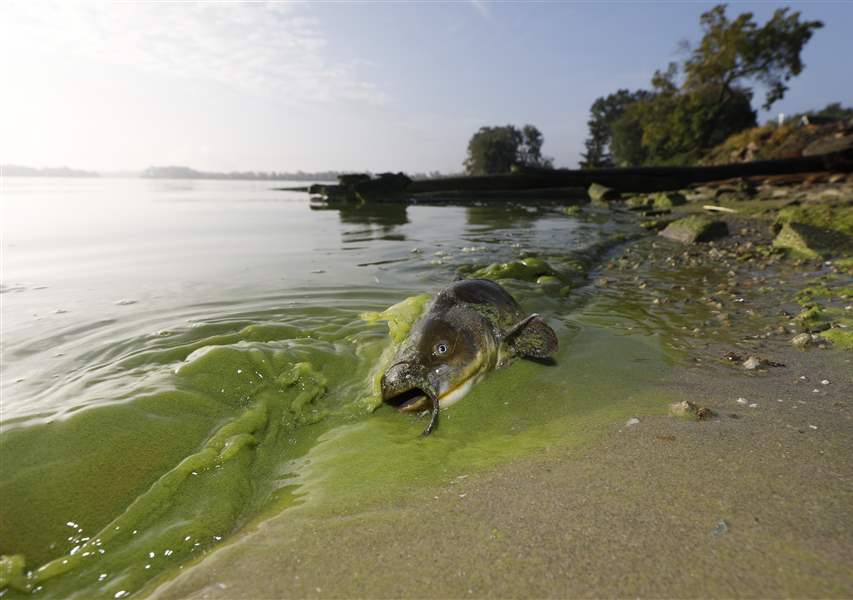
Green algae leads to water advisory for Maumee River near Downtown Toledo
9/21/2017
Algae in downtown Toledo, Wednesday, September 20.
The Blade/Andy Morrison
Buy This Image
A portion of the Maumee River that flows through Toledo was placed under a recreational advisory on Thursday by the Toledo-Lucas County Health Department because of a strong algal bloom.
Health officials said city tap water remains safe.
“This is just an advisory,” Health Commissioner Eric Zgodzinski said.
GALLERY: Green algae colors shore in Point Place
Mr. Zgodzinski later added the decision was based on visual observations and not test results.
He had no data about the concentration of any toxin that could be in the water.
Still, the department advised people to avoid contact with the Maumee River from the Anthony Wayne Bridge to the river’s mouth — especially between Promenade Park and and Cullen Park, where the bloom is strong.
Children, pregnant and nursing women, and those with compromised health are advised against swimming or wading in the river.
Mr. Zgodzinski said officials wanted to err on the side of caution and let people know it’s “probably not a good idea” to come into contact with water.
“If anybody’s seen the river in the section we’re talking about, it’s pretty green,” he said.
The city of Toledo maintained its water quality dashboard in the “clear” section Thursday, which means the raw lake water in the city’s intake 3 miles off the Oregon shoreline continued to have a microcystin concentration of less than 5 parts per billion, a level which operators at the Collins Park Water Treatment Plant can easily treat.
The intake is 10 feet below the lake’s surface, where the National Oceanic and Atmospheric Administration has reported a scum across much of the western basin.
“Our tap water is safe. We continue to monitor the microsystin in Lake Erie at the intake and the tap,” city spokesman Carrie Russell Hartman said.
At nearby Maumee Bay State Park in Oregon, an algal bloom in Lake Erie water near the shoreline was found to be at 30.9 parts per billion of the algal toxin microcystin on Sept. 11, according to the most recent testing results provided by the Ohio Department of Health.
That’s higher than the recreational contact threshold of 20 ppb for untreated water. The shoreline was posted off limits to swimming.
On Sept. 5 the area registered 250 ppb — more than 12 times the threshold.
The Maumee Bay State Park site is regularly tested by the state of Ohio, whereas the Maumee River shoreline is not tested by either the state or the local health department.
Microcystin is a potentially lethal toxin.
Scientists have long said the toxicity of a bloom does not necessarily correlate to its size. Yet the extremely dense green hue and thick texture of it lately has generated a lot of concern among shoreline residents, fishermen, and others in recent weeks.
Mike Ferner, Advocates for a Clean Lake Erie founder, said in an email Tuesday the water near his Point Place house looks worse than he’s ever seen it. Mr. Ferner lives north of Cullen Park, near Lake Erie’s Maumee Bay.
“In 35 years living at this spot on Lake Erie, I have never seen the water this bad,” he said.
Local health department officials put up signs at marinas and docks along the river warning would-be swimmers about the advisory. Health and city officials will monitor the situation and know more Friday when water test results are returned, Mr. Zgodzinski said.
“Tomorrow we could wake up and that river will have no green and it’ll be pushed out into the lake,” he said.
That’s not beyond the realm of possibility.
According to NOAA, the forecast calls for winds of 2 to 7 knots through Sunday. Although that “may increase the potential for scum formation” in some areas, the prevailing winds also could promote a more “northerly transport” of the bloom, NOAA said.
Health department officials advise people rinse skin immediately if they come in contact with water associated with the algal bloom. If someone develops symptoms such as rash, hives, blisters, severe diarrhea, vomiting, and abdominal pain — signs of exposure to a harmful algal bloom — they should seek medical attention.
Fishing, and eating fish out of the river is fine, Mr. Zgodzinski said.
Such a recreational advisory has happened elsewhere along the Maumee River in recent years, though not in Toledo.
In June, 2016, the Defiance County General Health District issued a recreational advisory for the river near Defiance because of algae. Defiance’s tap water remained safe, with no detectable microcystin in it; the city gets its drinking water from a reservoir, not directly from the river.
For more information, visit ohioalgaeinfo.com.
Contact Lauren Lindstrom at llindstrom@theblade.com, 419-724-6154, or on Twitter @lelindstrom.